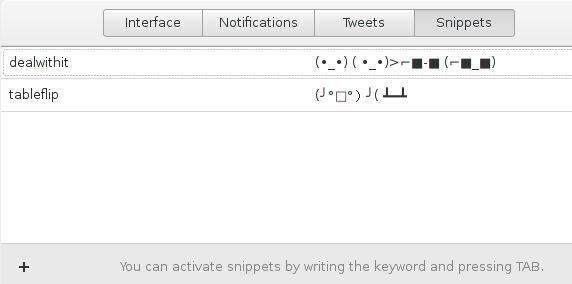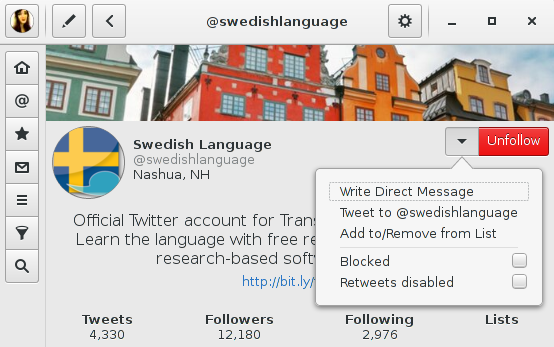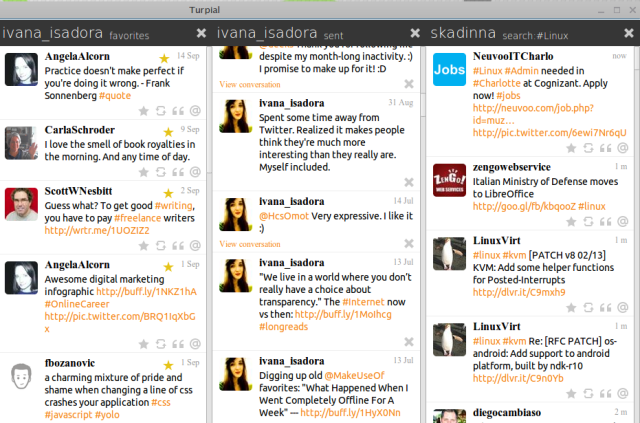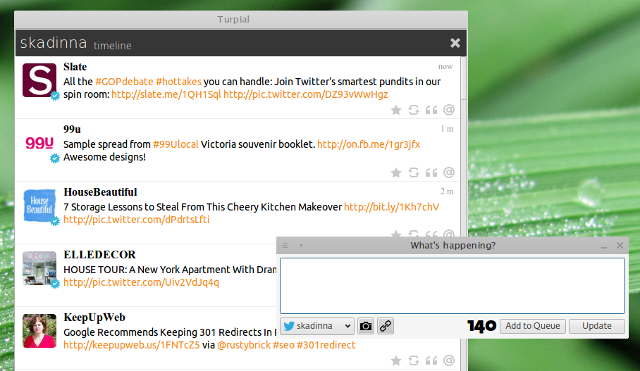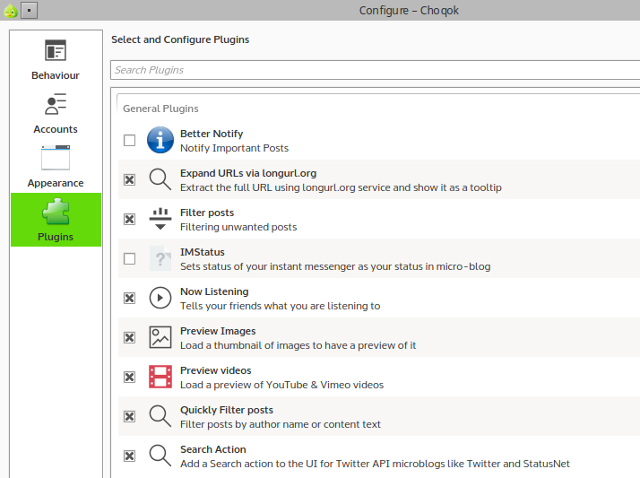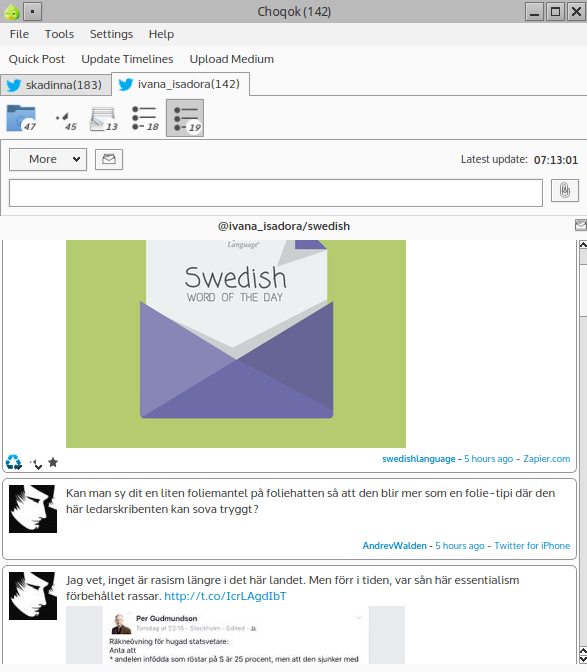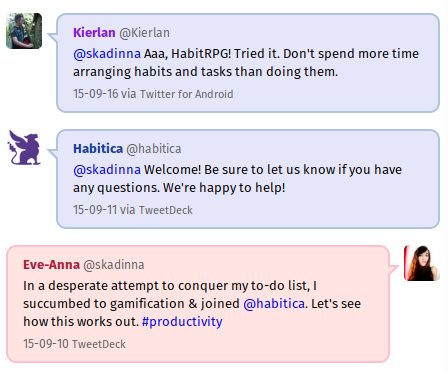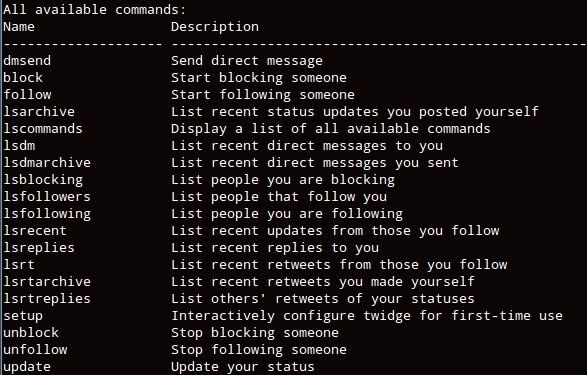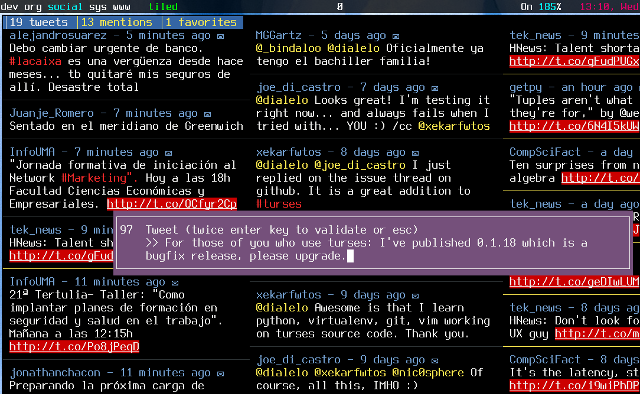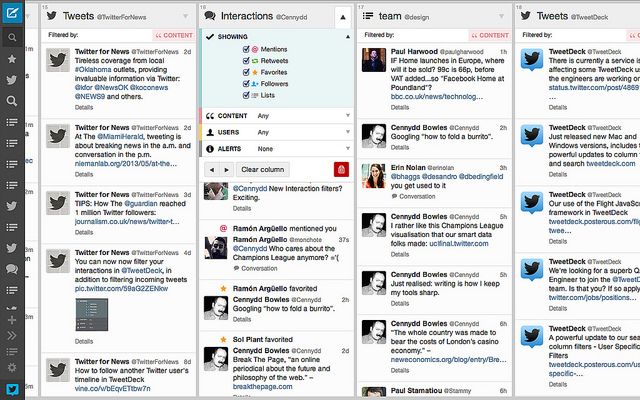Contrary to popular opinion, there are quite a few Twitter clients for Linux.
The only problem is that most of them suck.
Alright, that was a bit unfair. Polly is a great app, but its development is seemingly discontinued; the same fate befell several other Twitter clients. Rebranded as Friends in 2013, Gwibber is decent but underwhelming when you want to work with more than one Twitter account. These days, having multiple Twitter accounts doesn't make you a "weirdo". Many people prefer to split their private Twitter accounts from business-related ones. It's a smart practice if you care about personal branding.
Considering all that, what can you use to manage multiple Twitter accounts on Linux? Here are some suggestions.
Corebird
Young and fresh, Corebird has just one issue: the installation can be tricky. Not all distros have it in the repositories, so you might have to compile Corebird from source. Other than that, it's an attractive Twitter client a with a neat icon-based interface. Corebird boasts features like keyboard shortcuts, configurable notifications, and the ability to search for users and tweets within the app. It also lets you insert predefined snippets of text into your tweets.
Lists and Columns: You can access Twitter Lists via the designated icon in the main sidebar, but you can only view one list at a time. In other words, there is no multi-column view. However, you can add and remove users from lists.
Tweet Quoting and Conversation View: Corebird has both. Awesome.
User Management: Corebird lets you view any user's profile, follow and unfollow them, block and DM them, and disable their retweets. You can also view and edit your own profile bio directly from Corebird.
Tweeting and Beyond: To access retweet, reply, and favorite buttons, you have to right-click each tweet. When composing a new tweet, you can select the account from which to send it. There's no option for tweet scheduling. Filtering tweets by content is possible, and you can even use regular expressions for that.
Turpial
Turpial is a small Qt-based Twitter client that lets you configure features like notifications, updating frequency, and number of tweets in each column. It sports an impressive selection of URL shortening and image upload services. Searching for tweets and tracking hashtags works within Turpial—no need to launch the browser.
Lists and Columns: Turpial's biggest flaw is the fact it can't manage Twitter lists. You can still have multiple columns with your Home timeline, DMs, replies, retweets, favorites, and search results.
Tweet Quoting and Conversation View: The latter is present, but the new "Quote Tweet" feature is not.
User Management: You can preview users' profiles, follow and unfollow them, as well as mute their tweets.
Tweeting and Beyond: Turpial supports tweet scheduling—the feature is called Queue. You can easily pick an account from the dropdown menu when posting a tweet. Photos in tweets can be displayed inline.
Choqok
Choqok is an old favorite that we reviewed some time ago. A lot has changed in the meantime: it has been ported to Qt5 and prepared for Plasma 5 integration. Choqok is by far the most featureful Twitter client on this list, though this does come at a price (namely, a bunch of dependencies and occasional hiccups with KWallet). Integrated search, real-time hashtag tracking, keyboard shortcuts and detailed notification settings are just a few of its many strengths. The best part are plugins which you can toggle as you need them.
Lists and Columns: Every Twitter account is displayed as a tab, and under each tab you can collect as many lists and timelines as you want. They are represented by icons in the toolbar. Every icon displays an unread tweets count. You can define how many tweets should be loaded in every list and timeline, and toggle a helpful update timer that shows the last time you refreshed Choqok.
Tweet Quoting and Conversation View: There is no visible option to quote tweets, but the Manual Resend option lets you add comments to retweets. Conversation view is supported.
User Management: If you click on the tiny username at the bottom of each tweet, a small menu pops up. There you can view a user's profile, see their tweets and retweets, as well as follow, block, and even report them.
Tweeting and Beyond: You can choose the account from which to tweet and pick one of many image upload services and URL shortening tools. It's possible to mark all tweets as read, filter them by content and author, and hide individual posts in any timeline.
GFeedLine [No Longer Available]
This relatively unknown Twitter client has a lot to offer. Apart from managing multiple Twitter accounts, GFeedLine can be used with Facebook and Tumblr. The interface is zoomable, comes with full-screen mode and several themes you can customize if you're familiar with CSS.
Lists and Columns: GFeedLine has the best list management I've seen in a Twitter client. Columns are in fact tabs that you can divide into groups as you please. You're free to mix tabs from different Twitter accounts. For example, you can have a group with mentions and retweets of all your accounts, then another group with lists abour Linux, and a third one with direct messages. You can add your own lists or load public lists from another user.
Tweet Quoting and Conversation View: Tweet quoting is not yet available. Conversation view works, but not for direct messages.
User Management: Clicking a username opens the selected tweet in the browser. Clicking an avatar opens that user's profile in a separate GFeedLine tab. There are no visible options to follow users, but you can save a user's timeline as a permanent tab, which is basically like following them.
Tweeting and Beyond: Clicking an image opens it in the browser. Hovering over a tweet shows the buttons for common tweet actions. When writing a new tweet, you can choose the account from which to send it. Filtering tweets by content and sender is possible; tweet scheduling, however, is not.
CLI Clients Are Cool, Too
You may remember Matthew's recent article about lightweight Twitter apps that mentioned a few command-line clients. Apparently, geeks love Twitter, because there are plenty more of those. But can you manage multiple accounts with them?
Twidge
Once you install it, Twidge behaves like any other Linux command: it has "subcommands" and switches you can combine to load new tweets, retweets and replies. The most basic example is
twidge lsrecent -su
that will show 20 newest tweets in your Home timeline. Twidge can remember your last read tweet and show only new ones—or all of them.
You can block, follow, and unfollow users directly from Twidge. Sadly, it doesn't seem to support Twitter lists. URL shortening is possible, but you need to specify the service(s) you want to use in the configuration file. Having multiple accounts means simply creating multiple configuration files and loading them in individual instances of Twidge; for example, in separate tabs or windows of your favorite terminal emulator.
For tips and examples on how to use Twidge, consult the official documentation.
Turses
Turses is proof that a CLI application can look pretty. It features columns, offers the option to track hashtags, and lets you view any user's public timeline. With Turses, you can follow and unfollow users and send direct messages.
URL shortening and trimming are built-in, and links can be opened in the default browser. All customization is done by editing the configuration file. Multiple accounts can have their own configuration files, or you can define them as aliases of the default account. You can tell Turses how often to check for new tweets.
Downsides? Turses doesn't support Twitter lists, tweet filtering, nor the conversation view.
Other Ways to Manage Your Accounts
Do you remember the golden age of web-based Twitter clients? Most are defunct now due to changes in Twitter API. If you prefer this approach over desktop apps, take a look at Hubyard. It's an open source project that lets you connect multiple social media accounts and organize content into canvases. You can either use the online version (currently in beta, requires sign-up) or download the source and host it yourself.
I know it might be hard to believe, but IRC is not dead. If you're the type who spends a lot of time using an IRC client, you don't have to break your workflow because of Twitter. Now you can manage your Twitter accounts via IRC. You'll need BitlBee for this, and all the instructions are available in the official documentation.
Of course, you can just use Tweetdeck. It doesn't have a desktop version for Linux, and though it's free to use, it's not open source. Still, you can use it in your browser and change its appearance with Stylish in Firefox and Chrome. Features include tweet scheduling, account sharing, tweet quoting and conversation view, hiding retweets, desktop notifications, and much more. Since it's owned by Twitter, Tweetdeck usually gets all the latest goodies before other clients, so it's always at an advantage.
Now, let's hear it from you: how do you manage your Twitter accounts? Do you prefer desktop or web apps for this purpose? Leave your thoughts in the comments below.
Image Credits: colorful penguin by Olesia Misty via Shutterstock, Hubyard screenshot via Hubyard Twitter, Turses screenshot, tweetdeck-interactions-1 by Muhammad Rafizeldi via Flickr.



